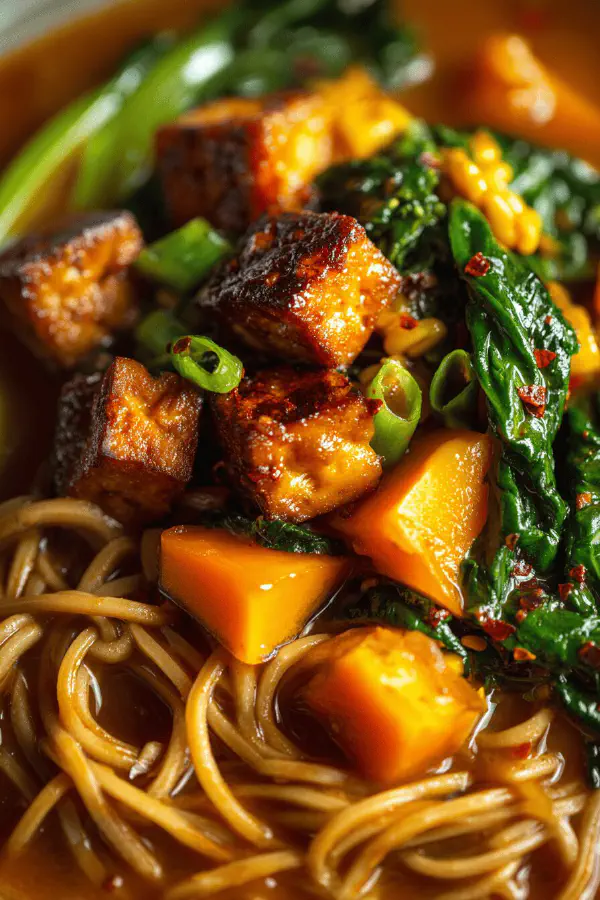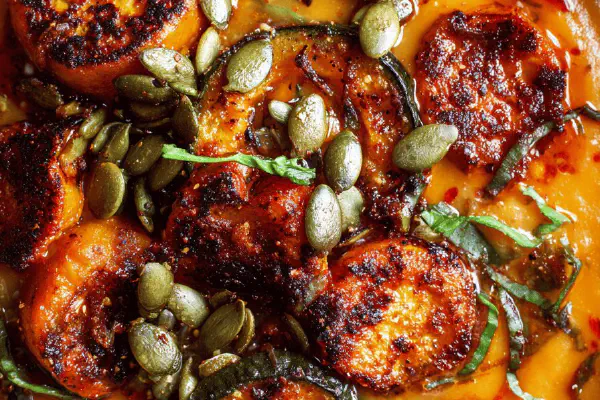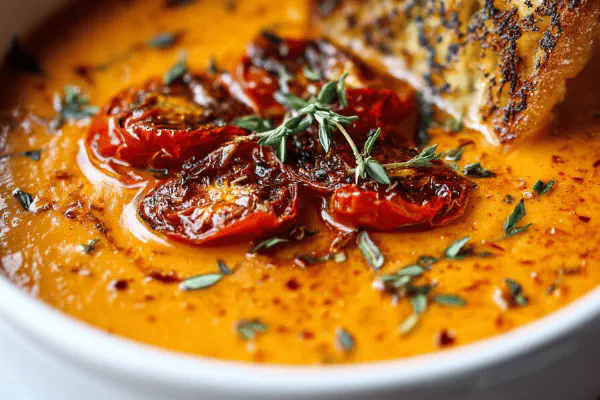Featured Recipe
Noodle Soup with Kabocha and Tempeh

By Kate
"
A hearty vegan noodle soup with roasted kabocha squash and tempeh cubes. Subtle heat from chili paste, balanced umami from coconut aminos. Broth infused with sesame, fresh corn kernels, and julienned parsnips add crunch. Spaghetti noodles serve as a familiar base, replaced with chewy tempeh for texture. Roasting kabocha brings out natural sweetness, while simmering veggies maintain bite. Garnished with scallions for freshness. Adaptable with common pantry swaps and simple steps to coax out deep flavors. Ideal midweek comfort with minimal fuss and maximum taste clarity.
"
Prep:
25 min
Cook:
30 min
Total:
55 min
Serves:
4 servings
vegan
soup
healthy eating
plant-based
weeknight meals
Introduction
Forget the predictable squash soups that fade to bland puree. Here, roasting kabocha wedges adds a caramelized backbone, a touch of crunch from parsnips keeps things lively, while tempeh—firm, toasted—not tofu—brings the earthy protein punch you can bite into. Broth’s built on the simple combo of veggie stock, coconut aminos for depth, and chili garlic paste for that familiar kick. Corn kernels sneak in a pop of sweetness and texture, balancing the heat. Spaghetti noodles? Familiar base to anchor the soup, no fuss. It’s about layering textures, roasting for flavor complexity, and smart swaps to keep it vegan but far from boring.
Ingredients
About the ingredients
Kabocha works brilliantly roasted because its dense flesh sweetens and caramelizes without falling apart. If unavailable, butternut squash is decent, though watch for sogginess. Red onion roasts slower than yellow; expect more caramel depth. Avocado oil’s neutral with high smoke point; olive oil is okay but use light version to avoid bitterness. Coconut aminos stand in for soy sauce—lower sodium, sweeter; regular tamari is fine but salt accordingly. Chili garlic paste adjusts heat; Sriracha or sambal oelek can substitute, but start low. Toasting tempeh cubes eliminates raw bitterness and moisture; firm tofu tends to crumble so tempeh wins here. Parsnips add crunch and mild sweetness, but carrot or celery root could work. Choose brown rice or spelt noodles as gluten-free or wheat-based options. Scallions are non-negotiable for fresh snap; add finely chopped cilantro for herbal twist.
Method
Technique Tips
Oven temperature matters; under-roasting squash yields stringy texture, over-roasting burns sugars. Check feel with fork gently—you want tender with resistance, not mush. Roasting the onion alongside creates sweet, umami-rich nuggets; no need to caramelize separately, saves time, pan space. Broth brought to simmer—not boil—prevents splitting the chili flavors or toughening delicate veggies like parsnips. Parboil noodles separately, drain, toss in sesame oil briefly to prevent clumping before serving. Toast tempeh dry and hot, flipping often to ensure even browning; wet or oily pan yields soggy results and bland flavor. Assemble just before serving to avoid soggy noodles. Garnish with scallions last—heat wilts their pop. Consider a rinse or soak if using tamari to limit salt. A squeeze of lime or a sprinkle of toasted sesame seeds per bowl livens up final serving. Store leftovers with noodles separate; reheat broth only to avoid overcooked pasta.
Chef's Notes
- 💡 Roast kabocha right. Don't skimp. Check for blisters on skin. Fork poke test gives you right feel. Not mushy yet tender. Let onions caramelize.
- 💡 Parsnips add crunch. Don’t overcook them. Simmer just enough. Snap at bite, not mush. Skipping them? Use carrots or celery root.
- 💡 Tempeh toasting matters. Hot, dry pan. No oil. 6-8 minutes. Watch for golden crust. Avoid bland pieces floating. Crisp texture adds depth.
- 💡 Adjust broth flavors. Coconut aminos vs. tamari—lower sodium to keep things balanced. Don’t drown in chili garlic. Start slow, taste as you go.
- 💡 Don’t combine noodles with broth until serving. Avoid soggy pasta. Toss them with sesame oil. Final assembly is crucial for texture.
Kitchen Wisdom
Can I substitute kabocha?
Yes, use butternut squash if kabocha is missing. Texture varies; watch sogginess. Adjust cooking time.
What if tempeh is unavailable?
Try firm tofu. Different texture; may crumble. Toast it first. Reduce moisture for better flavor.
How to store leftovers?
Keep noodles separate from broth. Broth stays good longer. Reheat gently to avoid overcooked noodles.
Broth tastes bland?
Boost with more coconut aminos or chili sauce. Taste as you go. Adjust with salt or add fresh herbs.



